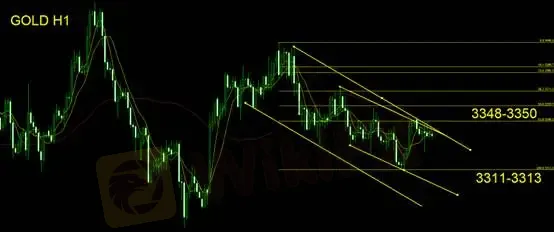简体中文
繁體中文
English
Pусский
日本語
ภาษาไทย
Tiếng Việt
Bahasa Indonesia
Español
हिन्दी
Filippiiniläinen
Français
Deutsch
Português
Türkçe
한국어
العربية
FOMC July Meeting Minutes Commentary: Monetary Policy at a Crossroads Amid Tariff Pressures
Sommario:The Federal Reserve‘s July meeting minutes highlight a policy dilemma: inflation remains above target, amplified by tariff effects, while economic momentum and labor conditions show signs of weakening
The Federal Reserve‘s July meeting minutes highlight a policy dilemma: inflation remains above target, amplified by tariff effects, while economic momentum and labor conditions show signs of weakening. This dual pressure underscores the Fed’s cautious, data-dependent stance.
Economic Growth Slows
U.S. economic growth weakened notably in the first half of the year. Q1 GDP contracted before a modest Q2 rebound, but momentum remains fragile. Consumer spending is cooling, housing investment has declined, and net exports—though positive—were driven mainly by front-loaded imports, a temporary effect.
Inflation Risks Persist
Headline PCE inflation stands at 2.5%, with core PCE at 2.7%, both above the Feds 2% target. Tariffs are raising goods prices, and while services inflation has eased slightly, it is insufficient to offset overall pressures.
Labor Market Cracks Emerging
Unemployment remains at 4.1%, near full employment, but with uneven distribution. Job gains are concentrated, certain groups face rising unemployment, and wage premiums for job-switchers are narrowing. Corporate surveys reveal firms remain cautious—delaying both hiring and layoffs amid uncertainty.
Financial Markets Show Optimism
Markets appear upbeat, led by tech stocks benefiting from AI-driven expectations. The S&P 500 has reached elevated valuations, and credit spreads have narrowed, signaling improved risk appetite. However, small-cap stocks remain subdued, showing limited breadth in the recovery. Financial conditions overall remain accommodative, providing some buffer.
Stability Risks and Tariff Debate
The minutes also highlighted concerns over high equity valuations, rising real estate loan defaults, banks rate exposure, and stablecoin-related risks. Tariffs dominated policy discussions. While some officials see tariffs as a one-off shock, others worry they will entrench sticky inflation.
This divide extends to policy views. Most members favor holding the federal funds rate at 4.25%–4.50% while awaiting further data. However, Governors Bowman and Waller supported a 25-basis-point cut, arguing that inflation—excluding tariffs—is near target, and employment risks are rising.
Balance Sheet and Liquidity
The Fed is continuing its quantitative tightening path, though Treasurys replenishment of the TGA account could cause short-term liquidity stress. SRF usage hit record highs at quarter-end, showing heightened demand for liquidity. The Fed pledged to closely monitor and support market stability as needed.
Outlook: Navigating Tariff Inflation and Jobs Weakness
The Feds biggest challenge lies in addressing both tariff-driven inflation and labor softness. Should inflation remain high, tightening will continue; if employment weakens sharply, easing will be considered. A stagflation scenario would complicate policy choices further.
The minutes set the stage for the Jackson Hole symposium. Chair Powell is expected to stress policy flexibility and the importance of anchoring long-term inflation expectations. Markets anticipate the September meeting could mark a turning point, though outcomes depend heavily on data.
In essence, the Fed is at a crossroads: it cannot ignore inflation risks nor overlook employment pressures. The message is clear—patience and data dependence will guide policy.
Conclusion
Market uncertainty has intensified, leaving investors caught between inflation and growth risks. Short-term trading may prove volatile, but those anchored to longer business cycles may find greater resilience. Monetary purchasing power remains the key driver of gold prices—a principle unchanged over the past century.
Gold Technical Analysis

Gold remains locked within a descending channel, struggling to break the $3,348–$3,350 resistance zone. Unless decisively breached, the trend bias stays bearish.
Trend: The week‘s first four sessions saw narrow but downward consolidation. Weekly and daily charts both lean lower.
Catalyst: Today’s central bank symposium may provide direction.
Strategy:
Shorts should keep tight stop-losses.
Flat positions may consider new shorts during the Asian session.
Risk Disclaimer: This analysis is for general market commentary only and does not represent the platforms stance. All readers must take responsibility for their own trading decisions.
Disclaimer:
Le opinioni di questo articolo rappresentano solo le opinioni personali dell’autore e non costituiscono consulenza in materia di investimenti per questa piattaforma. La piattaforma non garantisce l’accuratezza, la completezza e la tempestività delle informazioni relative all’articolo, né è responsabile delle perdite causate dall’uso o dall’affidamento delle informazioni relative all’articolo.
WikiFX Trader
TMGM
XM
Vantage
Plus500
FOREX.com
HFM
TMGM
XM
Vantage
Plus500
FOREX.com
HFM
WikiFX Trader
TMGM
XM
Vantage
Plus500
FOREX.com
HFM
TMGM
XM
Vantage
Plus500
FOREX.com
HFM
Rate Calc



